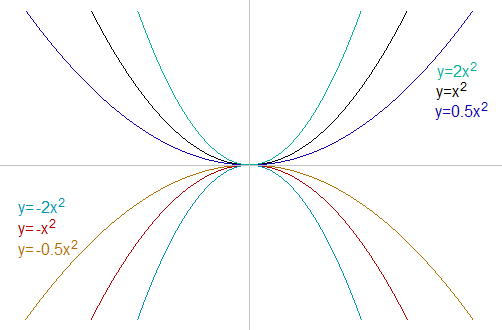Copyright © Had2Know 2010-2025. All Rights Reserved.
Terms of Use | Privacy Policy | Contact
Site Design by E. Emerson
How to Write a Parabolic Equation in Vertex Form
In algebra, there are three ways to write the equation of a parabola (2nd degree polynomial) in Cartesian coordinates. The standard form of a parabola is
y = f(x) = ax2 + bx + c.
The factored form is
y = f(x) = a(x - r)(x - s),
where r and s are the roots of the function, possibly complex numbers. The vertex form of a parabola is
y = f(x) = a(x - h)2 + k,
where h is the x-coordinate of vertex and k is the y-coordinate. In all three forms, the coefficient a governs the shape of the parabola. When a is positive, the curve is concave up, and when a is negative the curve is concave down. If a = 0 the function f(x) is a line. See figure below:

How to Convert from Standard Form to Vertex Form
The standard form is the most compact way to write the three terms of a second degree polynomial. However, if you need to draw the graph of a parabola, the vertex form is more convenient. The vertex is located at the point (h, k) and the parameter a indicates the general shape of the parabola. Once you have the equation in the form f(x) = a(x - h)2 + k, you have all the information you need to draw the curve.You can convert the standard form of a parabola to vertex form by completing the square. Doing this yields the relation:
ax2 + bx + c = a(x + b/2a)2 + c - b²/4a .
So h = - b/2a and k = c - b²/4a . You can also use the converter calculator above to quickly transform a parabolic equation into vertex form.
Example: Convert the parabola f(x) = 5x2 - 20x + 1 to vertex form. Solution: Since we have a = 5, b = 20, and c = 1, we plug these values into the equivalence relation above. This gives us
5x2 - 20x + 1 = 5(x - 20/(2*5))2 + 1 - (202)/(4*5)
= 5(x - 2)2 - 19
This means the vertex of the parabola is at the point (2, -19) and the parabola is concave up.
© Had2Know 2010
